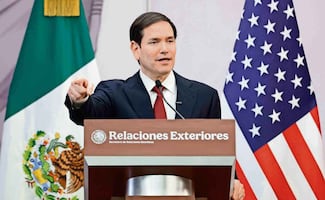Más Información

New York Times destaca rol de Harfuch en el combate del narco; resalta intercambio de inteligencia con EU

Marco Rubio destaca labor de seguridad de México; "están haciendo más que nunca en su historia", afirma

"Queremos cerrar este capítulo", dice Salinas Pliego al SAT; esperarán a enero a conocer fundamentos legales de adeudo fiscal
Mexico is developing rules that would cap the amount of cash that can used to buy real estate, Finance Minister Carlos Urzúa said on Friday , part of a push to reduce the use of physical currency in a country rife with money laundering and corruption.
Urzúa, speaking at a banking convention in the resort town of Acapulco , said the government was also considering rules that would require all its payments and collections to be processed electronically.
Contactless payments, digital wallets, and direct transfers through mobile phones are some of the new methods that government authorities and banking institutions throughout the globe are implementing to reduce the use of cash and expand the use of digital money.
In a country where 95% of payments are made with cash , one of the main challenges for the expansion of electronic payment methods is to eliminate the population’s fear of online transactions. This becomes particularly relevant when mobile phones have a market penetration of 107 million units in Mexico.
Mexican consumers are seeing an increase in digital payment methods through mobile phones that have proven effective in foreign markets. Furthermore, card payment collections are getting easier by the minute.
The Quick Response code system now seems to dominate banking transactions. A QR code consists of black squares arranged in a square grid on a white background, which can be read by mobile phones and makes it easier for users to approve money transfers or online payments.
Thereupon, Mexico’s Central Bank (Banxico) is currently developing a platform for digital transactions meant to serve as an operating base for payments and transfers via mobile phone. A pilot program will be launched later this month and it is expected to begin operating by the third quarter of 2019.
Retail banking clients in Mexico will now have more contactless payment options for their debit and credit cards, which will allow customers to conduct immediate transactions without using cards.
Some major players in the financial sector have announced work plans and larger security investments so that contactless payment operations in Mexico may be easily adopted by users.
“Contactless payments and digital security are two of our main priorities. We have made sustained efforts in the past few years to implement this strategy since it has proven to work satisfactorily in several financial markets,” said the electronic payments director for Mastercard in Mexico, Edgar García .
According to the National Banking Commission , the number of contracts for online transactions through mobile phones grew by 63% at the end of 2018, with a total of 24.8 million . From 2012 to date, digital payments have shown an exponential growth. However, there is a considerable gap to consider, given that only 37.3 million Mexicans have bank accounts .
Nearly 57 percent of people in Mexico work off the books
, according to government data. Millions lack bank accounts and an estimated 90 percent of all transactions are done in cash.
President Andrés Manuel López Obrador
, who took office in December, has made it one of his priorities to draw more people into the formal economy and reduce cash in circulation to cut down on the laundering of proceeds from the drug trade and other illicit activities.
dm
Noticias según tus intereses
[Publicidad]
[Publicidad]












